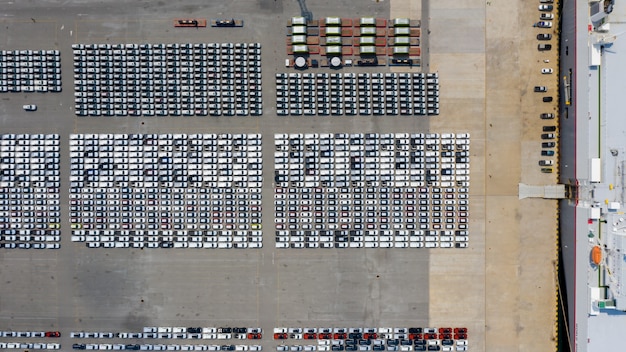Decoding US Trade Policy Shifts: Impact on Manufacturing

Decoding the recent shift in US trade policy and its impact on manufacturing involves analyzing new trade agreements, tariffs, and regulations, and understanding how these changes affect domestic production, international competitiveness, and supply chains within the United States.
Understanding the complexities of international trade is critical for businesses, especially those in the manufacturing sector. Decoding the recent shift in US trade policy and its impact on manufacturing requires a deep dive into the evolving landscape of trade agreements, tariffs, and international relations.
Understanding the Evolving US Trade Landscape
The United States has experienced significant shifts in its trade policies in recent years. These changes are driven by a variety of factors, including economic nationalism, national security concerns, and the desire to rebalance trade relationships. Understanding these underlying drivers is essential for interpreting current policies and anticipating future developments.
Key Drivers of Recent US Trade Policy Changes
Several factors have contributed to the recent changes in US trade policy. These include the rise of economic nationalism, which prioritizes domestic production and job creation; concerns about national security, which have led to restrictions on trade in certain sectors; and the perception that existing trade agreements are unfair to the United States.
- Economic Nationalism: The focus on bringing back manufacturing jobs to the US and reducing reliance on foreign suppliers.
- National Security: Protecting critical industries and technologies from foreign control.
- Trade Imbalances: Addressing the trade deficit and perceived unfair trade practices by other countries.
These drivers have led to a more protectionist trade stance, characterized by increased tariffs, stricter enforcement of trade laws, and a willingness to challenge existing trade agreements.
Major Trade Policy Changes and Their Scope
Recent years have seen several major shifts in US trade policy. These changes have affected a wide range of industries and countries, and their impact continues to be felt throughout the global economy. Understanding the scope of these changes is crucial for businesses seeking to navigate the new trade landscape.

Tariffs on Imported Goods
One of the most visible changes in US trade policy has been the imposition of tariffs on imported goods. These tariffs have been applied to a wide range of products, including steel, aluminum, and consumer goods, and have sparked retaliatory measures from other countries.
The rationale behind these tariffs is to protect domestic industries from foreign competition and encourage companies to produce goods in the United States. However, tariffs also increase the cost of imported goods for consumers and businesses, and can disrupt supply chains.
Renegotiation of Trade Agreements
The US has also sought to renegotiate existing trade agreements, such as the North American Free Trade Agreement (NAFTA), to better reflect its interests. The renegotiated agreement, known as the United States-Mexico-Canada Agreement (USMCA), includes new provisions on labor rights, environmental protection, and intellectual property.
The goal of these renegotiations is to create fairer trade relationships and address perceived shortcomings in existing agreements. However, renegotiating trade agreements can be a lengthy and complex process, and can create uncertainty for businesses.
The recent shifts in US trade policy represent a significant departure from the past, with potentially far-reaching consequences for the global economy.
Immediate Effects on US Manufacturing
The new US trade policies have had immediate and noticeable effects on the manufacturing sector. Industries reliant on imported raw materials and components have faced increased costs, while those competing with foreign imports have seen some benefits.
- Increased Input Costs: Tariffs on steel, aluminum, and other raw materials have raised production costs for many manufacturers.
- Supply Chain Disruptions: Companies have been forced to reevaluate their supply chains to mitigate the impact of tariffs and trade restrictions.
- Competitive Pressures: Some manufacturers have gained a competitive advantage due to tariffs on imported goods, while others have struggled to adapt to the changing trade landscape.
The manufacturing sector has had to quickly adapt to these changes, exploring new sourcing strategies and adjusting production processes to remain competitive.
Long-Term Implications for Manufacturing Competitiveness
The long-term implications of the recent trade policy changes on US manufacturing competitiveness are complex and uncertain. While some policies may provide short-term benefits for certain industries, others could undermine the overall competitiveness of the manufacturing sector in the long run.

Potential Benefits
One potential benefit of the new trade policies is the reshoring of manufacturing jobs to the United States. Tariffs and other trade restrictions could make it more attractive for companies to produce goods domestically, leading to increased investment and job creation in the manufacturing sector.
Additionally, the renegotiation of trade agreements could create fairer trade relationships and protect US intellectual property, which could benefit innovative manufacturing companies.
Potential Risks
However, there are also significant risks associated with the new trade policies. Increased tariffs could raise costs for manufacturers, making them less competitive in global markets. Supply chain disruptions could also lead to production delays and inefficiencies.
Furthermore, retaliatory measures from other countries could harm US manufacturers by limiting their access to foreign markets.
The long-term impact on manufacturing competitiveness will depend on how these policies are implemented and how businesses adapt to the changing trade landscape.
Strategies for Manufacturers to Adapt
Given the uncertainty surrounding the future of US trade policy, manufacturers need to develop strategies to adapt to the changing environment. These strategies include diversifying supply chains, investing in automation, and seeking new export markets.
Diversifying Supply Chains
One way for manufacturers to mitigate the impact of tariffs and trade restrictions is to diversify their supply chains. This involves sourcing raw materials and components from multiple countries, rather than relying on a single supplier.
Investing in Automation
Another strategy is to invest in automation to improve productivity and reduce labor costs. Automation can help manufacturers become more competitive, even in the face of higher input costs.
Manufacturers can also use this moment to rethink supply chains.
- Near-shoring: Moving production closer to the US, reducing transit times and improving responsiveness.
- Strategic Partnerships: Collaborating with foreign suppliers to navigate trade barriers and foster innovation.
- Technology Adoption: Implementing AI and machine learning to optimize supply chain management and reduce costs.
Navigating Geopolitical Factors
Geopolitical factors significantly influence US trade policy. Understanding these factors is critical for manufacturers to make informed decisions.
Geopolitical factors play a crucial role in shaping US trade policy. These factors include the rise of China, tensions between the US and other countries, and global instability.
Manufacturers must stay informed about these developments and factor them into their strategic planning.
Staying informed, agile, and proactive will be essential for manufacturers to navigate the evolving trade landscape effectively.
| Key Point | Brief Description |
|---|---|
| 📈 Trade Policy Shifts | Recent US trade policy changes include tariffs and renegotiated agreements. |
| 🏭 Impact on Manufacturing | Changes impact production costs, competition, and global supply chains. |
| 🌍 Adaptation Strategies | Manufacturers can adapt by diversifying, automating, and exploring new markets. |
| 🌐 Geopolitical Influence | Geopolitical events significantly shape US trade policies. |
Frequently Asked Questions
▼
The main factors include economic nationalism, national security concerns, and the desire to address trade imbalances.
▼
Tariffs have generally raised the cost of imported raw materials like steel and aluminum, increasing production expenses.
▼
They can diversify supply chains, invest in automation, and explore new export markets to mitigate risks.
▼
USMCA includes updated provisions on labor rights, environmental protection, and intellectual property rights.
▼
Geopolitical events can significantly influence trade policy, impacting market access and supply chain stability.
Conclusion
In conclusion, the evolving US trade policy presents both challenges and opportunities for the manufacturing sector. By understanding these changes and proactively adapting their strategies, manufacturers can navigate the new landscape and maintain their competitiveness in the global economy.





